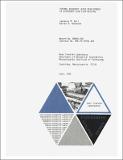Thermal boundary layer development in dispersed flow film boiling
Author(s)
Hull, Lawrence M.; Rohsenow, Warren M.
DownloadHTL_TR_1982_104.pdf (5.838Mb)
Other Contributors
Massachusetts Institute of Technology. Division of Sponsored Research.
Massachusetts Institute of Technology. Dept. of Mechanical Engineering.
Massachusetts Institute of Technology. Heat Transfer Laboratory.
Metadata
Show full item recordAbstract
Dispersed flow film boiling consists of a dispersion of droplets which are carried over a very hot surface by their vapor. This process occurs in cryogenic equipment and wet steam turbines. It is also of interest in the analysis of a nuclear reactor loss of coolant accident and many other applications. The integral approach to boundary layer theory is first used to analyze heat transfer to the turbulent flow of single phase vapor in the entrance region of a circular tube. The single phase predictions compare well with published correlations and data. The integral analysis is then extended to analyze the heat transfer to turbulent dispersed flow. A numerical solution and a simplified explicit solution for the dispersed flow case are presented. These analyses are verified by comparisons to experimental data. An experiment was designed which allowed control over the key parameters appearing in the analysis: vapor Reynolds number, quality, and drop diameter. The heat transfer tests were carried out at vapor Reynolds numbers of 2x10 4 and 4x10. The quality varied between 10% and 50%. A photographic study of the dispersion provided the estimates of the drop sizes. For each pair of Reynolds number and quality, a test with relatively large drops and one with relatively small drops was carried out. This provided an experimental parametric study in addition to the data required for the model verification.
Date issued
1982Publisher
Cambridge, Mass. : Heat Transfer Laboratory, Dept. of Mechanical Engineering, Massachusetts Istitute of Technology, [1982]
Other identifiers
10849149
Series/Report no.
Technical report (Massachusetts Institute of Technology, Heat Transfer Laboratory) ; no. 104.